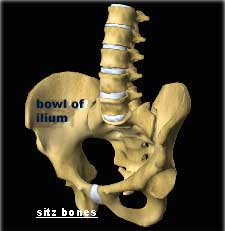|
Home Site Map CDs 4 Steps Lifestyle Relaxation Yoga meditation 50+ Meditations |
||
|
|
-------
Ischial-Tuberosity In sitting for meditation, what is most important, as Patanjali says in Yoga Sutras, is that the posture be sthira (steady, stable, motionless) and sukham (comfortable, ease filled) (Yoga Sutra 2.46). These qualities should be cultivated regardless of which specific posture you use for meditation. Swami Rama repeatedly explains that these are far more important than the specific position of the legs and arms; what matters in position is that the spine is aligned.
In addition, one should sit so that the body weight is resting on the two bones known as Tuberocity of the Ischium or the Isahial Tuberosity, which are also known as the Sitz bones. These two knobs or bumps are shown at the bottom in the graphic above. Although not technically accurate, these two bone protuberances have come to be known in common language (and physical yoga classes) as the "sits" bones or the "sitting" bones, probably due to people not knowing the correct spelling of the Sitz bones (using the letter "z"). By carefully, mindfully working with the position of the whole of your hips and spine, you will find this to be both steady and comfortable. With a proper cushion it is very comfortable to sit with your entire body weight resting on these two bone knobs or bumps.
-------
|
|


